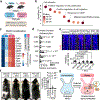Hyperactivation of sympathetic nerves drives depletion of melanocyte stem cells
- PMID: 31969699
- PMCID: PMC7184936
- DOI: 10.1038/s41586-020-1935-3
Hyperactivation of sympathetic nerves drives depletion of melanocyte stem cells
Abstract
Empirical and anecdotal evidence has associated stress with accelerated hair greying (formation of unpigmented hairs)1,2, but so far there has been little scientific validation of this link. Here we report that, in mice, acute stress leads to hair greying through the fast depletion of melanocyte stem cells. Using a combination of adrenalectomy, denervation, chemogenetics3,4, cell ablation and knockout of the adrenergic receptor specifically in melanocyte stem cells, we find that the stress-induced loss of melanocyte stem cells is independent of immune attack or adrenal stress hormones. Instead, hair greying results from activation of the sympathetic nerves that innervate the melanocyte stem-cell niche. Under conditions of stress, the activation of these sympathetic nerves leads to burst release of the neurotransmitter noradrenaline (also known as norepinephrine). This causes quiescent melanocyte stem cells to proliferate rapidly, and is followed by their differentiation, migration and permanent depletion from the niche. Transient suppression of the proliferation of melanocyte stem cells prevents stress-induced hair greying. Our study demonstrates that neuronal activity that is induced by acute stress can drive a rapid and permanent loss of somatic stem cells, and illustrates an example in which the maintenance of somatic stem cells is directly influenced by the overall physiological state of the organism.
Conflict of interest statement
COMPETING INTERESTS
L.I.Z. is a founder and stockholder of Fate Therapeutics, Inc., Scholar Rock and Camp4 Therapeutics. D.E.F has a financial interest in Soltego, Inc., a company developing SIK inhibitors for topical skin darkening treatments that might be used for a broad set of human applications. D.E.F’s interests were reviewed and are managed by Massachusetts General Hospital and Partners HealthCare in accordance with their conflict of interest policies. A.R. is an SAB member of ThermoFisher Scientific, Neogene Therapeutics, Asimov, and Syros Pharmaceuticals, an equity holder of Immunitas, and a founder and an equity holder of Celsius Therapeutics. I.M.C. is an SAB member of GSK pharmaceuticals and Kintai pharmaceuticals. A provisional patent application has been filed based on this work (Applicants: President and Fellows of Harvard College and The General Hospital Corporation; Inventors: Y-C.H., D.E.F., B.Z., and I.R.; Application number: 62/903,517; Status: pending/provisional; Aspect covered: Methods and compositions for controlling hair greying. All other authors declare no competing interests.
Figures













Comment in
-
How the stress of fight or flight turns hair white.Nature. 2020 Jan;577(7792):623-624. doi: 10.1038/d41586-019-03949-8. Nature. 2020. PMID: 31988402 Free PMC article.
-
Zu viel Stress führt zu vorzeitigem Ergrauen.MMW Fortschr Med. 2020 Feb;162(3):34. doi: 10.1007/s15006-020-0154-z. MMW Fortschr Med. 2020. PMID: 32072532 Review. German. No abstract available.
-
The Psychology of Gray Hair.Dev Cell. 2020 Mar 9;52(5):548-549. doi: 10.1016/j.devcel.2020.02.008. Dev Cell. 2020. PMID: 32155437
References
-
- Ephraim AJ On sudden or rapid whitening of the hair. AMA Arch Derm 79, 228–236 (1959). - PubMed
-
- Navarini AA & Nobbe S Marie Antoinette syndrome. Arch Dermatol 145, 656–656 (2009). - PubMed
-
- Müller-Röver S et al. A comprehensive guide for the accurate classification of murine hair follicles in distinct hair cycle stages. Journal of Investigative Dermatology 117, 3–15 (2001). - PubMed
Publication types
MeSH terms
Substances
Grants and funding
- R01 AI100119/AI/NIAID NIH HHS/United States
- R01 AR072304/AR/NIAMS NIH HHS/United States
- R01 AR070825/AR/NIAMS NIH HHS/United States
- R01 AR043369-23/NH/NIH HHS/United States
- DP2 AT009499/AT/NCCIH NIH HHS/United States
- P01 CA163222/CA/NCI NIH HHS/United States
- T32 GM007598/GM/NIGMS NIH HHS/United States
- R01 CA103846/CA/NCI NIH HHS/United States
- R01 AI130019/AI/NIAID NIH HHS/United States
- R01 CA222871/CA/NCI NIH HHS/United States
- R01 AR043369/AR/NIAMS NIH HHS/United States
- HHMI/Howard Hughes Medical Institute/United States
LinkOut - more resources
Full Text Sources
Other Literature Sources
Medical
Molecular Biology Databases

